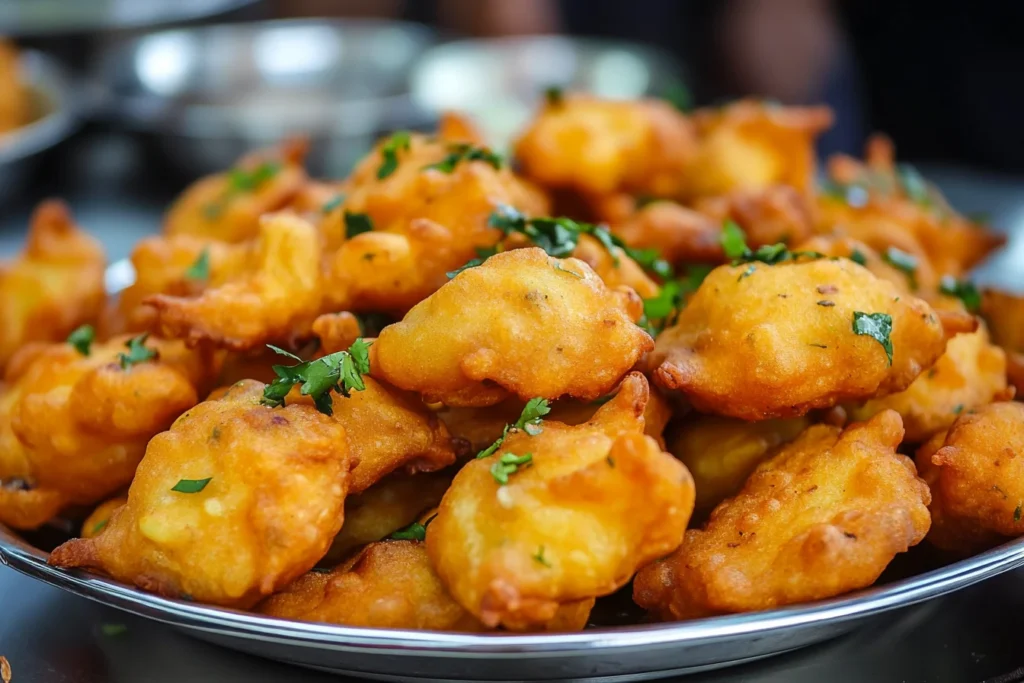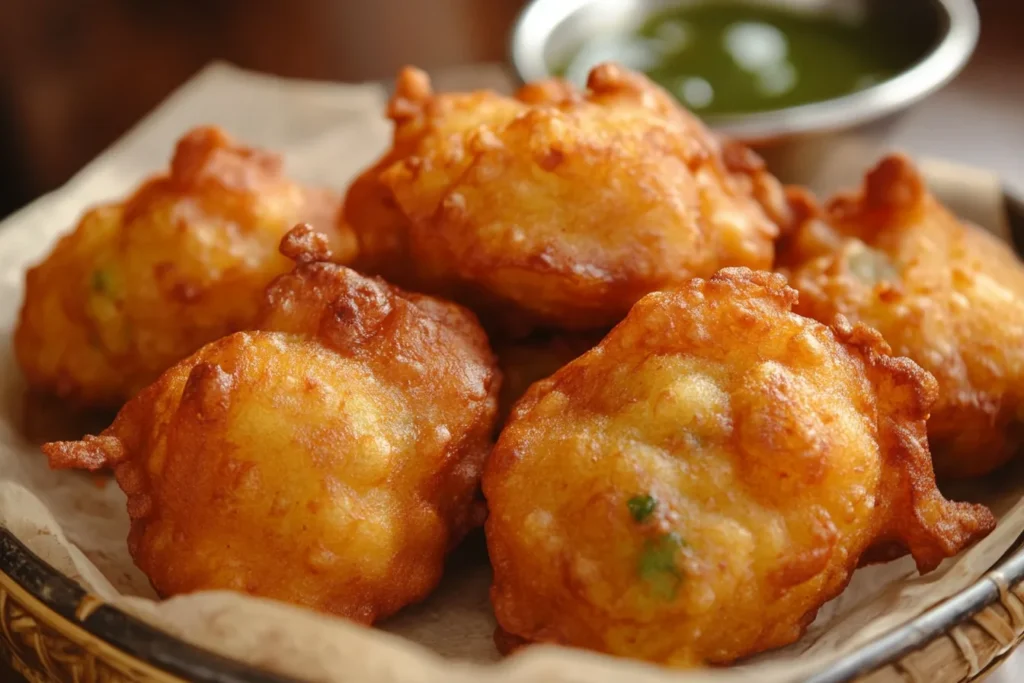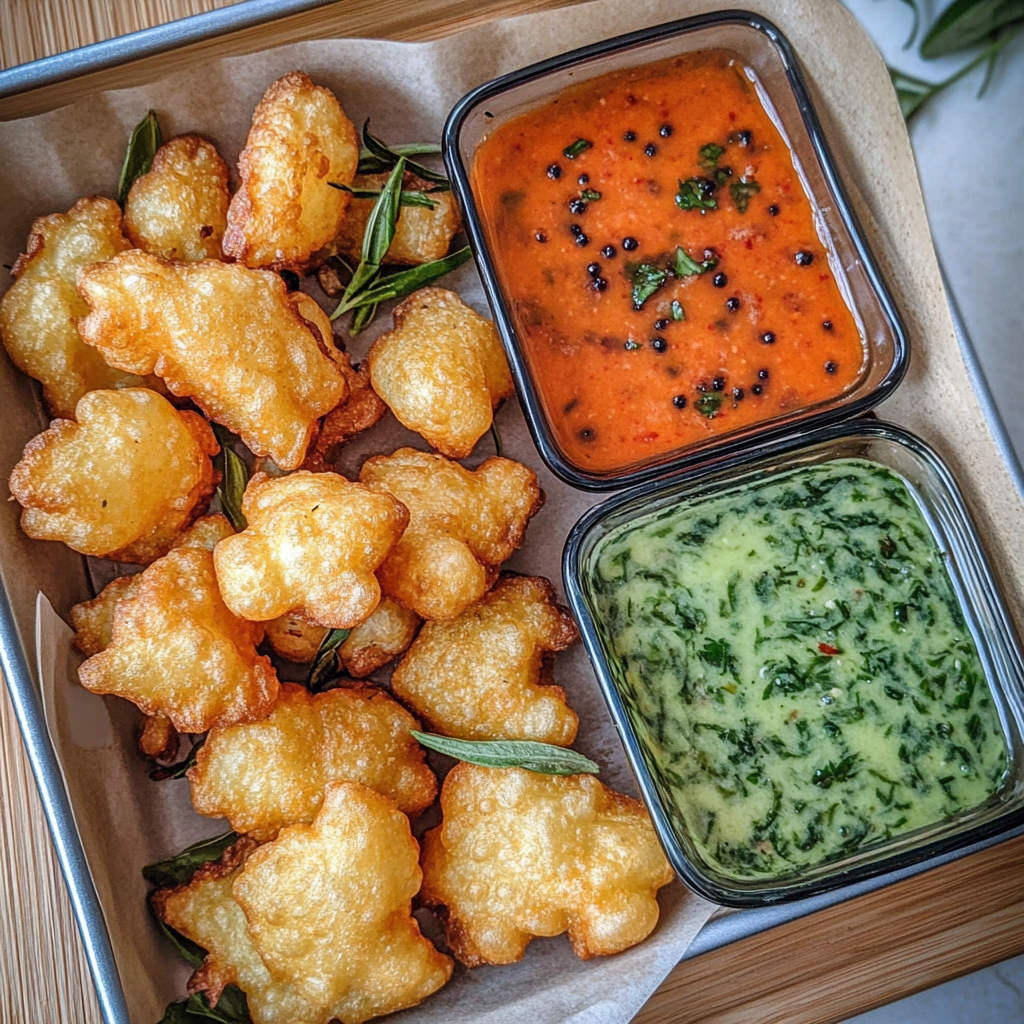Part 1: Introduction to Kanda Bhajiya in English
1. What is Kanda Bhajiya in English?
this snack is a popular Indian snack made primarily from thinly sliced onions coated in a spiced chickpea flour batter and deep-fried to crispy perfection. Known for its crunchy texture and rich flavor, it is a quintessential street food that resonates with Indian culinary traditions. Served with chutneys or a hot cup of tea, it is often enjoyed during rainy weather or festive gatherings.
2. Literal English Translation: Onion Fritters
The literal translation of Kanda Bhajiya in English is “Onion Fritters.” The word “Kanda” means onion in Marathi (a regional language spoken in Maharashtra, India), while “Bhajiya” refers to fritters or small fried snacks. These fritters bear similarities to onion rings in the Western world but have a distinctively spiced flavor that makes them unique.
3. Origins of Kanda Bhajiya
Kanda Bhajiya has its roots in the Indian state of Maharashtra, where it is believed to have originated as a simple snack to pair with tea. Over time, it became a beloved street food across India. The dish draws influence from India’s ancient culinary heritage, where frying and the use of chickpea flour (besan) were integral cooking techniques.
4. Cultural Significance in India
In India, Kanda Bhajiya is more than just food—it is a cultural experience. It is deeply tied to the monsoon season, where enjoying hot, crispy bhajiyas with a cup of chai (tea) becomes a cherished tradition. From casual family evenings to roadside tea stalls, these fritters bring people together, transcending socio-economic boundaries.
5. Variations Across India
While Kanda Bhajiya has its roots in Maharashtra, its popularity has led to regional adaptations:
- Pakoras in North India: These are similar fritters but often include a variety of vegetables like potatoes and spinach.
- Pyaz Pakoda in Rajasthan: A spicier version of onion fritters, often paired with tamarind chutney.
- Onion Bajjis in South India: A crispier variant, served with coconut chutney or sambar.
Each region adds its own twist, making the dish versatile and deeply ingrained in India’s diverse culinary landscape.
6. Role of Kanda Bhajiya in Street Food
Kanda Bhajiya occupies a prominent spot in India’s street food scene. Vendors across bustling markets and train stations prepare these fritters fresh, drawing crowds with their aroma. Their affordability and quick preparation make them a go-to snack for busy commuters and tourists alike.
7. Popularity Beyond Maharashtra
Though originating in Maharashtra, Kanda Bhajiya has gained popularity across India. In urban areas like Delhi, Mumbai, and Bengaluru, you’ll find it on menus at cafes, restaurants, and food trucks. Its widespread appeal stems from its simplicity, flavor, and versatility.
8. Comparison with International Dishes
Kanda Bhajiya shares similarities with international dishes like:
- Onion Rings (USA): While onion rings are larger and typically coated in breadcrumbs, Kanda Bhajiya is thinner, spiced, and uses chickpea flour.
- Tempura (Japan): Like this snack, tempura involves frying vegetables in batter, though tempura batter is lighter and less spiced.
9. Traditional Versus Modern Preparations
Traditionally, Kanda Bhajiya is made using a simple mix of onions, chickpea flour, and a few spices. Modern variations, however, incorporate diverse ingredients like garlic, coriander, and green chilies for added flavor. In some cases, air-fryers have replaced deep frying to cater to health-conscious audiences.
10. Overview of Ingredients Used
The core ingredients for Kanda Bhajiya include:
- Onions: Thinly sliced for even frying.
- Chickpea Flour (Besan): Forms the base of the batter.
- Spices: Commonly used spices include turmeric, red chili powder, cumin, and ajwain (carom seeds).
- Water: To create a smooth batter consistency.
- Oil: For deep frying.
Optional ingredients such as green chilies, coriander leaves, and rice flour enhance flavor and texture.

Part 2: Recipe and Cooking Process
1. Key Ingredients for Kanda Bhajiya
The beauty of this snack lies in its simplicity, with ingredients that are often staples in Indian households. Here’s a detailed breakdown of what you’ll need:
- Onions: Thinly sliced; red onions or white onions work best.
- Chickpea Flour (Besan): Provides the base for the batter, ensuring a crispy texture.
- Spices:
- Turmeric powder for color and mild earthiness.
- Red chili powder for heat.
- Carom seeds (ajwain) for a subtle, peppery flavor.
- Asafoetida (hing) for digestive benefits.
- Green Chilies and Coriander Leaves: For a fresh, zesty kick.
- Rice Flour: Optional, but adds extra crunch.
- Water: To form the batter.
- Salt: Enhances the flavors.
- Oil: For deep frying.
2. How to Make the Perfect Batter
The batter is the foundation of any good Kanda Bhajiya. To get it right:
- Combine dry ingredients: Mix chickpea flour, rice flour, turmeric, red chili powder, ajwain, and salt in a bowl.
- Add onions: Coat the thinly sliced onions in the dry mixture. This ensures even seasoning.
- Incorporate water slowly: Gradually add water, mixing until the batter clings to the onions without becoming too runny.
- Taste test: Always check for seasoning before frying.
Pro Tip: Avoid over-mixing the batter; this can make the fritters dense instead of light and crispy.
3. Techniques for Frying
Frying is an art when it comes to Kanda Bhajiya. Follow these steps for the perfect fritters:
- Choose the right oil: Use oils with a high smoke point, like sunflower or peanut oil.
- Preheat the oil: Heat it to about 180°C (350°F). Test with a drop of batter—it should sizzle and rise to the top.
- Avoid overcrowding: Fry in small batches to ensure even cooking.
- Flip carefully: Use a slotted spoon to turn the fritters halfway through frying.
- Drain excess oil: Place fried bhajiyas on a paper towel to absorb excess grease.
4. Secret Tips for Crispy Onion Fritters
To achieve the perfect crunch:
- Add rice flour: A small amount in the batter increases crispiness.
- Rest the batter: Let the batter sit for 5–10 minutes before frying. This allows the flavors to meld.
- Use chilled water: Cold water in the batter can enhance the texture.
- Don’t over-batter: Too much batter can make the fritters soggy.
5. Common Mistakes to Avoid
Here are some pitfalls to watch out for:
- Too much water in the batter: This can make the fritters heavy and oily.
- Low frying temperature: Leads to soggy, oil-soaked bhajiyas.
- Overcrowding the pan: Prevents even cooking.
- Skipping rice flour: Makes the fritters less crunchy.
6. Step-by-Step Recipe Guide
Ingredients:
- 2 large onions
- 1 cup chickpea flour
- 2 tbsp rice flour
- 1 tsp turmeric
- 1 tsp red chili powder
- 1 tsp ajwain
- 2–3 green chilies (finely chopped)
- Handful of coriander leaves (chopped)
- Salt to taste
- Oil for frying
Instructions:
- Prepare onions: Thinly slice onions and separate the layers.
- Mix dry ingredients: In a large bowl, combine chickpea flour, rice flour, and spices.
- Coat onions: Add sliced onions, green chilies, and coriander. Mix well.
- Add water: Slowly pour water into the mixture, ensuring it’s just enough to coat the onions.
- Heat oil: Preheat oil in a deep frying pan.
- Fry fritters: Drop spoonfuls of the mixture into the hot oil. Fry until golden brown.
- Drain: Remove fritters with a slotted spoon and place on paper towels.
- Serve: Enjoy hot with chutney or tea.

7. Variations in Recipes
While the traditional recipe is a classic, these variations can elevate your Kanda Bhajiya:
- Spicy Bhajiya: Add extra red chili powder or garam masala for heat.
- Herbed Bhajiya: Include mint or dill for a refreshing twist.
- Paneer Bhajiya: Add small cubes of paneer (Indian cottage cheese) to the batter.
- Gluten-Free Bhajiya: Use only chickpea flour and skip rice flour for a gluten-free option.
8. How to Serve Kanda Bhajiya
Serving Kanda Bhajiya is as important as cooking it:
- With chutneys: Pair with tangy tamarind chutney or spicy mint-coriander chutney.
- As a side dish: Serve alongside dal and rice for a comforting meal.
- As a snack: Enjoy with ketchup or a squeeze of lemon.
9. Pairing Kanda Bhajiya with Beverages
this snack shines when paired with the right drinks:
- Masala Chai: A spiced tea that complements the fritters’ savory flavor.
- Coffee: A hot cup of strong coffee balances the spiciness.
- Lemonade: A refreshing beverage to counter the heaviness of fried food.
10. Making Kanda Bhajiya Healthier
For health-conscious food lovers:
- Air-fry instead of deep-fry: Use an air fryer to reduce oil consumption.
- Add vegetables: Incorporate grated carrots or spinach for added nutrients.
- Bake instead of fry: Bake the fritters at 200°C (400°F) for 20–25 minutes.
Part 3: Cultural and Culinary Perspectives
1. Importance of Kanda Bhajiya in Indian Monsoons
The monsoon season in India is synonymous with hot tea and Kanda Bhajiya. As rain pours outside, families huddle indoors, enjoying the crispy fritters that perfectly complement the cold weather. This pairing has become almost ritualistic, symbolizing comfort and togetherness.
Street vendors flourish during monsoons, with the aroma of fresh bhajiyas wafting through narrow lanes. The combination of Kanda Bhajiya and chai represents Indian hospitality and the simple joys of life.
2. Street Vendors and Their Unique Styles
Across India, street vendors bring creativity to their Kanda Bhajiya. Each vendor has a signature touch:
- Some add extra spices like garam masala for a bold flavor.
- Others fry the fritters smaller, making them bite-sized and convenient for on-the-go snacking.
- Vendors in Mumbai’s bustling streets often serve bhajiyas with pav (bread), creating a filling and flavorful sandwich.
This diversity of preparation and presentation ensures that no two plates of Kanda Bhajiya are ever the same.
3. Regional Variations of Onion Fritters
The regional interpretations of Kanda Bhajiya showcase India’s culinary diversity:
- North India: Known as “pyaz pakoda,” the fritters are often spiced with garam masala and served with tamarind chutney.
- South India: Called “onion bajji,” these fritters are thinner and crispier, frequently paired with coconut chutney.
- West Bengal: Referred to as “peyaji,” this version uses mustard oil for frying, lending a unique flavor.
- Maharashtra: The classic Kanda Bhajiya, often paired with green chutney or served in a vada pav-style snack.
4. Kanda Bhajiya in Indian Homes
Homemade this snack carries a sense of nostalgia for many Indians. It’s a dish often prepared during family gatherings or rainy evenings. The preparation process itself becomes a bonding activity, with family members slicing onions and mixing the batter together. The first batch is usually sampled hot off the stove, evoking a sense of joy and comfort.
5. Influence on Fusion Cuisine
In modern culinary trends, Kanda Bhajiya has inspired several fusion dishes:
- Bhajiya Burgers: Crispy onion fritters stuffed into burger buns with spicy mayo.
- Onion Fritter Tacos: A creative twist where fritters replace traditional taco fillings.
- Bhajiya Pizza: Thin fritters used as toppings on a spiced pizza base.
These adaptations demonstrate how Kanda Bhajiya has transcended traditional boundaries to find a place in contemporary cuisine.
6. Kanda Bhajiya as a Festive Snack
No Indian festival is complete without snacks, and Kanda Bhajiya often finds its way to the menu. During festivals like Ganesh Chaturthi or Diwali, these fritters are served alongside sweets and other savory items. They are also a favorite during wedding celebrations and family reunions.
7. Global Recognition of Indian Snacks
With the global rise of Indian cuisine, Kanda Bhajiya has gained international attention. Indian restaurants around the world now include “Onion Fritters” on their menus, often labeled as a quintessential Indian appetizer. Food bloggers and chefs abroad have embraced this snack, introducing it to wider audiences and pairing it with global flavors like aioli or sriracha sauce.
8. Restaurants Serving Authentic Kanda Bhajiya
Many Indian restaurants, especially in urban hubs, have mastered the art of this snackanda Bhajiya. Some popular ones include:
- Chai Point (India): Known for serving bhajiyas with authentic Indian chai.
- Swati Snacks (Mumbai): Celebrated for their crispy and fresh preparation.
- Dishoom (London): A globally renowned chain offering a luxurious take on this humble snack.
These establishments have elevated the status of Kanda Bhajiya while retaining its authentic flavors.
9. How Kanda Bhajiya Fits Into Vegan and Vegetarian Diets
Kanda Bhajiya is naturally vegetarian and can easily be made vegan. The batter contains no dairy or animal products, making it a great snack for those following plant-based diets. As the popularity of veganism grows globally, Kanda Bhajiya has emerged as a favorite for its rich taste and simplicity.
10. The Nostalgic Connection of Kanda Bhajiya with Indian Families
For many Indians, Kanda Bhajiya evokes a deep sense of nostalgia. It’s a dish that recalls childhood memories of rainy days, family picnics, or visits to grandparents’ homes. The simplicity of the recipe and the warmth it brings make it more than just a snack—it’s a slice of home.

More FAQs:
- What does Kanda Bhajiya mean in English?
- It translates to “Onion Fritters.”
- Can Kanda Bhajiya be made gluten-free?
- Yes, by using only chickpea flour and skipping any wheat-based additions.
- What makes Kanda Bhajiya crispy?
- Adding rice flour to the batter and frying at the right temperature.
- Is Kanda Bhajiya vegan?
- Naturally, yes, as it contains no dairy or animal products.
- Can I air-fry this snack?
- Absolutely. Air-frying reduces oil content while retaining crunchiness.
- What is the best accompaniment for Kanda Bhajiya?
- It pairs wonderfully with masala chai and green chutney.
- Can other vegetables be used in place of onions?
- Yes, potatoes, spinach, or even paneer work well in fritters.
- Why is this snack associated with monsoons?
- Its hot and crispy texture complements the cool, rainy weather, making it a seasonal favorite.
- How long does it take to cook Kanda Bhajiya?
- Around 20–25 minutes, including preparation and frying.
- Are onion fritters popular outside India?
- Yes, variations of onion fritters exist worldwide, like tempura in Japan and onion rings in the USA.
Related Article : Bhajiya Recipes

